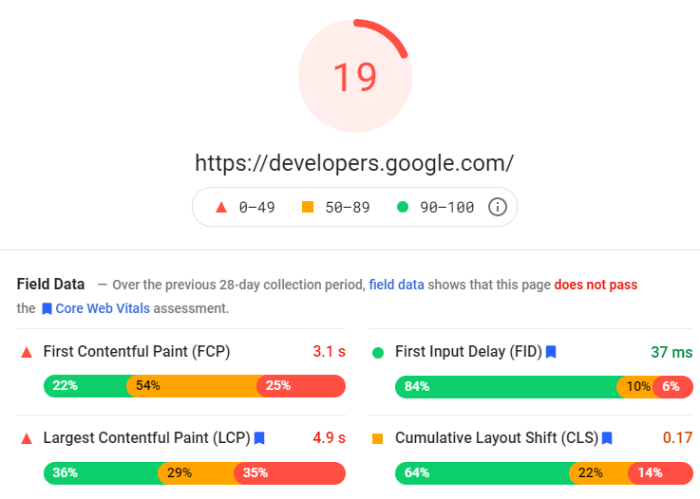Understanding Google’s Page Experience Update sets the stage for this enthralling narrative, offering readers a glimpse into a story that is rich in detail with american high school hip style and brimming with originality from the outset.
Google’s Page Experience Update is a game-changer for website owners, focusing on Core Web Vitals, mobile-friendliness, safe browsing, HTTPS, and intrusive interstitial guidelines. Dive into the world of website optimization with this update!
Overview of Google’s Page Experience Update: Understanding Google’s Page Experience Update
Google’s Page Experience Update is a significant algorithm update that focuses on enhancing user experience on websites. It is crucial for website owners as it directly impacts search rankings and overall user satisfaction.
Main Components of the Update
- Core Web Vitals: These are key metrics related to speed, responsiveness, and visual stability of a webpage.
- Mobile-friendliness: Ensuring that websites are optimized for mobile devices to provide a seamless user experience.
- Safe browsing: Websites must be free from malware, phishing, and other security threats to protect users.
- HTTPS: Secure connections are essential for user privacy and data protection.
- Intrusive interstitial guidelines: Pop-ups or interstitials that disrupt user experience can negatively impact rankings.
The update emphasizes the importance of these components to create a positive browsing experience for users. By meeting these criteria, websites can improve their search rankings and attract more organic traffic.
Core Web Vitals

Core Web Vitals are a set of specific factors that Google considers important in determining the overall user experience of a website. These metrics focus on aspects like page loading speed, interactivity, and visual stability, all of which contribute to a user-friendly and engaging website experience.
Largest Contentful Paint (LCP)
Largest Contentful Paint measures the loading performance of a webpage by determining how long it takes for the largest content element to become visible to the user. To optimize LCP, ensure that your server response times are fast, prioritize loading critical content first, and minimize render-blocking resources.
First Input Delay (FID)
First Input Delay evaluates the responsiveness of a webpage by measuring the time it takes for the page to respond to user interactions, such as clicks or taps. To improve FID, minimize JavaScript execution time, defer non-essential third-party scripts, and use browser caching to reduce load times.
Cumulative Layout Shift (CLS), Understanding Google’s Page Experience Update
Cumulative Layout Shift focuses on visual stability by measuring the amount of unexpected layout shifts that occur during the loading process. To enhance CLS, ensure that all page elements have defined sizes and dimensions, avoid dynamically injected content that can shift the layout, and implement image and video loading attributes to prevent sudden layout changes.
Mobile-Friendliness
In today’s digital age, mobile-friendliness is crucial for websites to provide a seamless user experience, especially with the upcoming Google Page Experience Update. Ensuring that your website is optimized for mobile devices can significantly impact your site’s performance and ranking on search engine results pages.
The Importance of Mobile-Friendliness
Having a mobile-friendly website is essential as more users access the internet through their smartphones and tablets. Google prioritizes mobile-friendly websites in search rankings, making it imperative for businesses to adapt to this trend. A mobile-friendly site not only improves user experience but also reduces bounce rates and increases conversions.
- Implement Responsive Design: Utilize responsive design to ensure your website adapts to different screen sizes and devices seamlessly.
- Optimize for Mobile: Optimize images, videos, and content for faster loading times on mobile devices.
- Use Mobile-Friendly Fonts: Choose legible fonts and font sizes that are easy to read on smaller screens.
- Ensure Easy Navigation: Simplify navigation menus and buttons for touch-screen interaction.
- Test for Mobile Usability: Use Google’s Mobile-Friendly Test tool to identify and fix any mobile usability issues.
Safe Browsing, HTTPS, and Intrusive Interstitials

Safe browsing and HTTPS play a crucial role in Google’s Page Experience Update by ensuring a secure and trustworthy online environment for users. Websites that implement HTTPS encryption and follow safe browsing practices contribute to a more secure user experience, ultimately enhancing their rankings on search engine results pages.
HTTPS and Safe Browsing
- HTTPS encryption secures the connection between the user’s browser and the website, protecting sensitive data such as login credentials and payment information from potential cyber threats.
- Safe browsing practices involve monitoring websites for malicious content, phishing scams, and other harmful elements that could compromise user safety.
- Websites that prioritize HTTPS and safe browsing not only provide a safer browsing experience for users but also build trust and credibility with both visitors and search engines.
Intrusive Interstitials
Intrusive interstitials are pop-ups or overlays that obstruct the main content of a webpage, negatively impacting user interaction and experience. These interstitials often disrupt the user’s ability to access the desired content or navigate the website smoothly, leading to frustration and potential abandonment of the site.
- Google considers intrusive interstitials as a hindrance to a positive user experience, as they can be perceived as intrusive and disruptive to the user’s browsing journey.
- Examples of intrusive interstitials include full-page pop-ups that appear immediately after landing on a page, forcing users to interact with the ad or content before accessing the main information.
- Websites that prioritize user-friendly practices and avoid intrusive interstitials are more likely to provide a seamless and engaging experience for visitors, ultimately leading to higher user satisfaction and retention rates.
